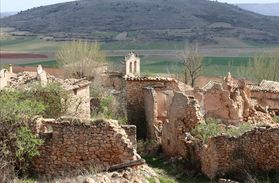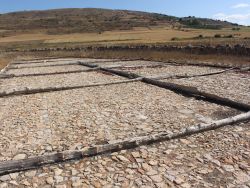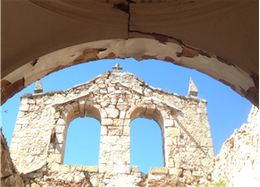An Introduction to Bujalcayado
Welcome to Bujalcayado - a classic Castillian village, born of the Reconquista.
The village is one of several close to Siguenza founded in the 12th and 13th centuries as feudal “town and country communes” so to re-populate the countryside in the wake of the expulsion of the Moors. The name of Bujalcayado derives from Arabic, meaning "The tower of the shepherds crook", indicating that one of the Iberia-wide network of moorish watchtowers was once situated somewhere on this hilltop.
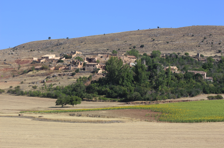
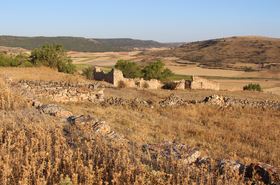
Bujalcayado, like other such villages of this region, was conceived and grew as the core of its own compact physical and social ecosystem. It is situated on a hillside springline, whose crystal water has gushed for centuries from springs (fuentes) channeled to a terraced complex of irrigated market gardens (huertas); and captured to sustain villagers and livestock during the arid summers and freezing winters.
In the valley below there are arable fields for wheat and barley, which was still harvested by hand until the 1950’s and carried on mules to the threshing platforms (heras) still preserved at the top of the village. The flour was baked to make bread in the communal village oven (horno), which is soon to be restored.
The uplands beyond (monte) were designated to the village as common oak forest and grazing land (baldios) where the villagers ran flocks of sheep and goats and even pigs, which could be fed on acorns to produce pork and cured hams. And the monte is still a traditional source of honey, lavender for essences, wild mushrooms, wild thyme, wild camomile – and wild walks with stunning views of mountains to the West, snowcapped in winter.
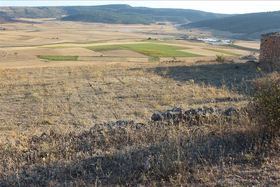
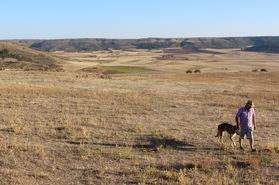
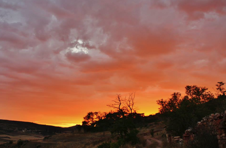
The village was organised as a virtual co-operative, with specific families responsible for tasks such as shepherding the villagers’ sheep and pigs or tending the bees. Each family had rights to grazing, exploitation of the monte, to cultivating their own huertas for fruit and vegetables, to use of the village oven, and to land for planting cereal crops in the valley. In return for tending the sheep, the shepherds were provided with food – as indeed was the village priest.
The wealth of the village however came mainly from another resource in the valley below; the fluvial salt pans (salinas), river-fed from warm saline springs welling up from the subterranean strata of the Triassic sea bed. The salinas of Bujalcayado, though now abandoned, can still be visited and will one day be restored. These salinas and others nearby, once owned by the Bishop of Siguenza and then by the monarchy, provided the wealth to build Siguenza Cathedral and also the 12th Century Church of Santa Quiteria in Bujalcayado itself. The salt from this region also became a significantly valuable resource (for preserving cod and other foods) during the creation of the Spanish empire. B the early 18th century accounted for almost a tenth of the revenue of the Spanish crown.
The church was for many centuries at the centre of village life. Although it sadly collapsed into ruins in the 1900s, along with many of the village houses, its walls, bell tower and altar dome remain as fine examples of the classical Rural Romanesque style.
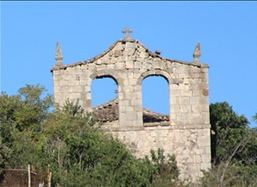
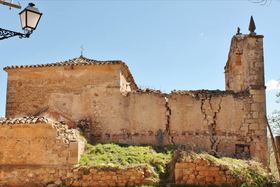
The village is now in the fifth year to save and restore the church. All the progress can be found in each stages within the projects page
It is probable that the population of Bujalcayado peaked at about 500 in the mid 19th century, by when sheep grazing for meat and wool and the cultivation of wheat, barley and sunflowers in the valley below had become very profitable. There was however a steady process of depopulation of the Spanish rural villages throughout the 20th century, evidenced by the sight here of so many ruined houses and outbuildings .
This decline has begun slowly to be reversed, now that the recreational value of village life and the natural beauty of this unspoilt countryside has become rediscovered, and some features of the traditional economy are already being revived.
For the casual visitor, there is a sense of history and the rare tranquility of timeless scenery to enjoy; perhaps recalling the survival skills of bygone village society; perhaps just pausing to absorb the views, cooled or braced by the Castillian breeze; or perhaps with a refreshing cup of the springwater that still gushes and gushes again into the fuente of the main square.
Thanks to Friends of Bujalcayado.
This website is managed and has been built by Gordon Wilkinson with the help of his brother, Simon (& his company Webigence Ltd) to share the beauty and history of Bujalcayado and raise awareness of the efforts being made to restore its church and livelihood. Thanks are due to all those who are giving their time, skills and donations to this project, especially Valentin Berrocal Garcia, the Mayor and project leader, Philip Wilson for the videos, The Pete Wilson Blues Band, Allan Green for designing the logo, and also Milcia Lopez and Mick Green for their photos and editorial content. We hope that they will be joined by more and more friends, as we and the village progress.
